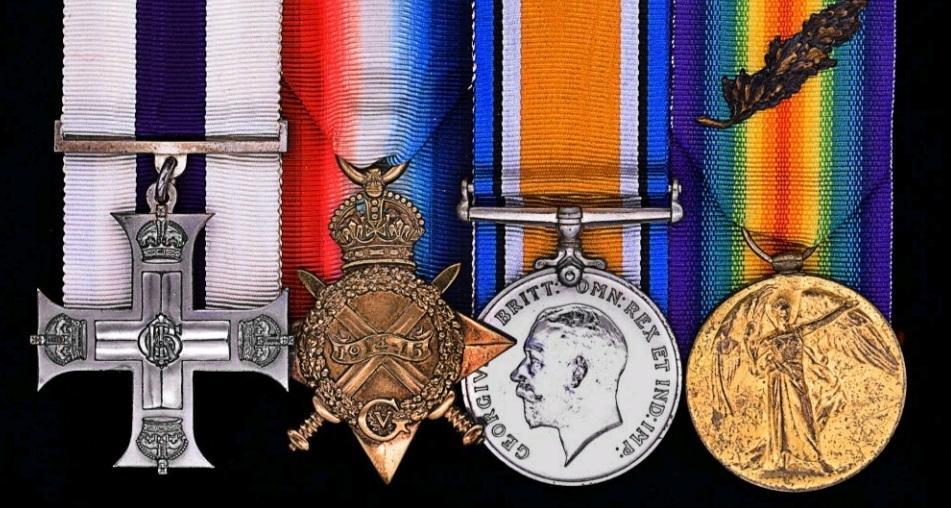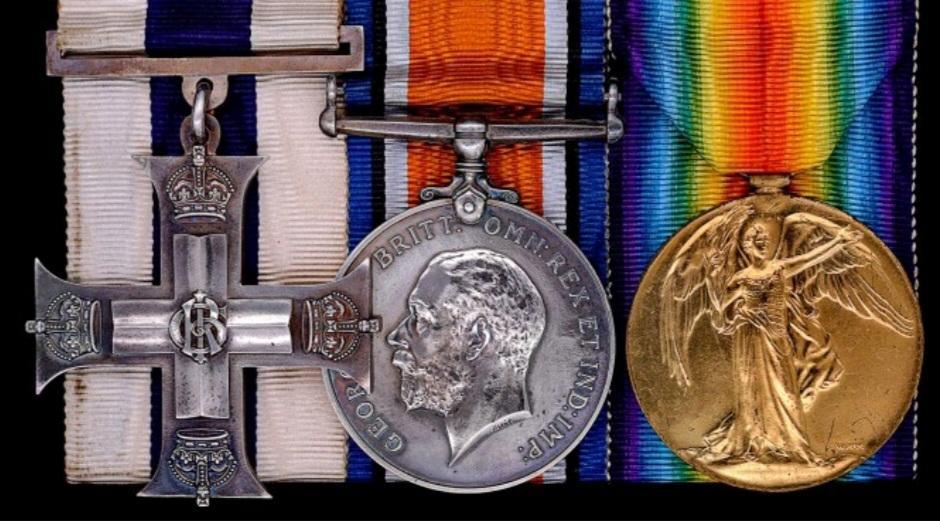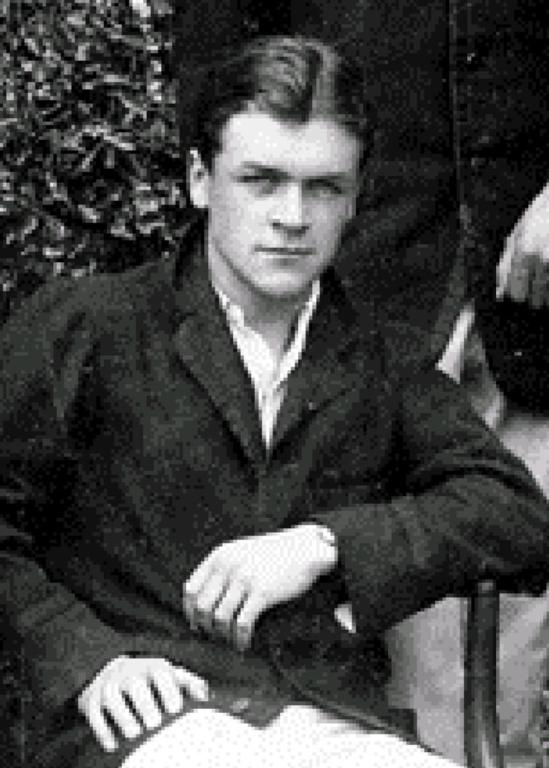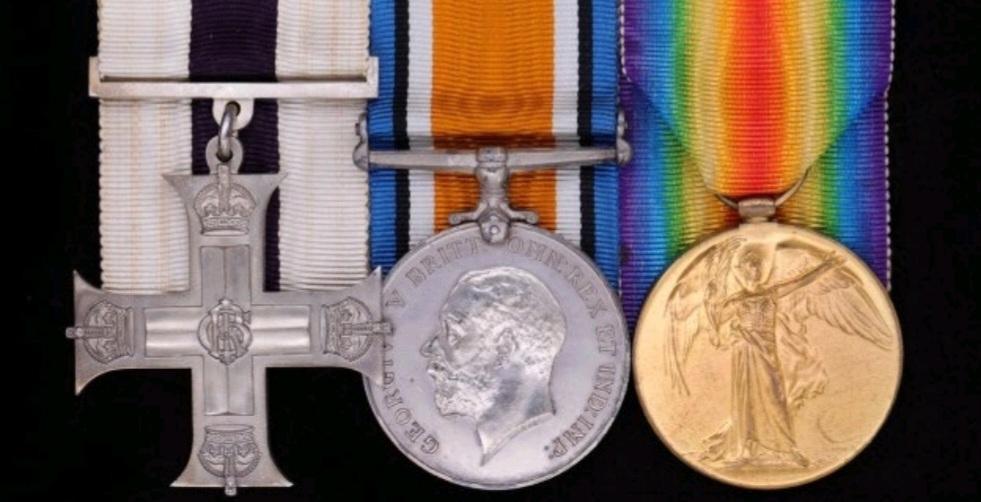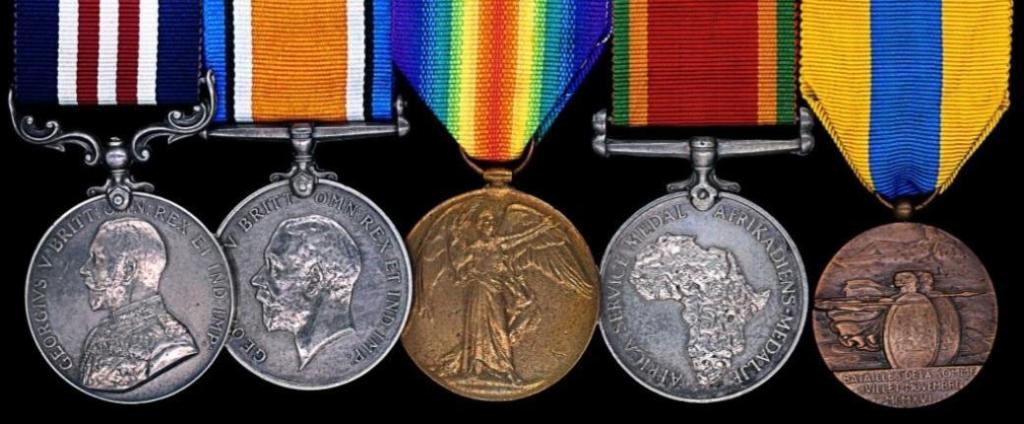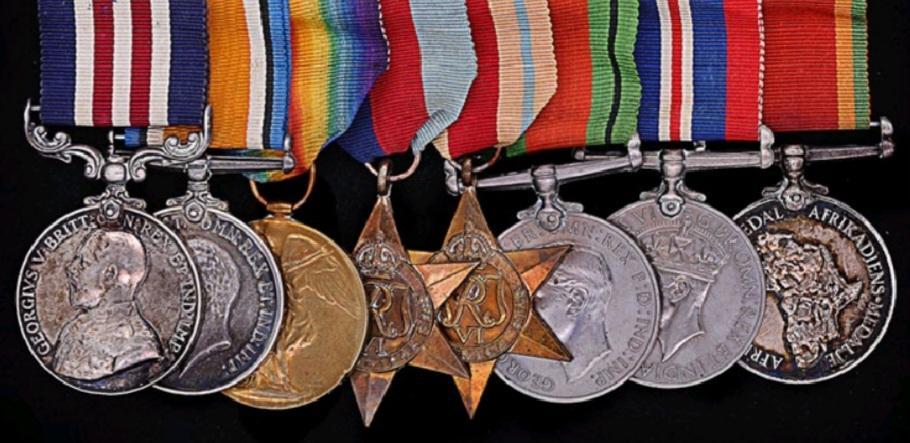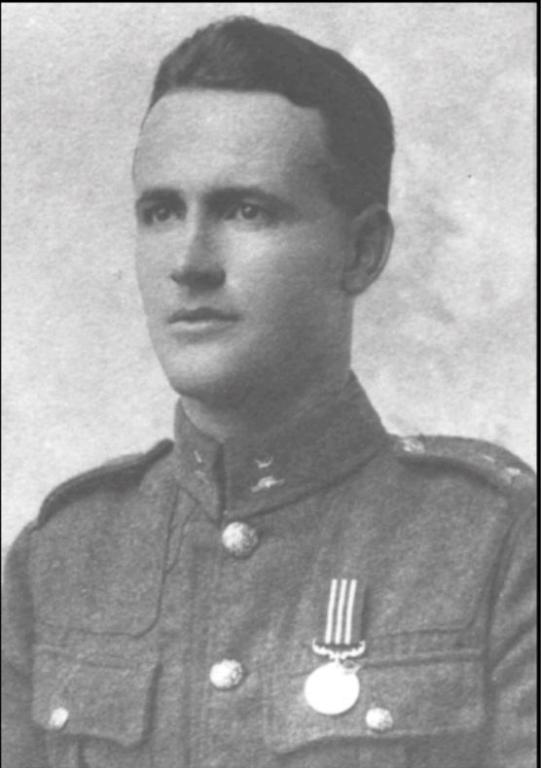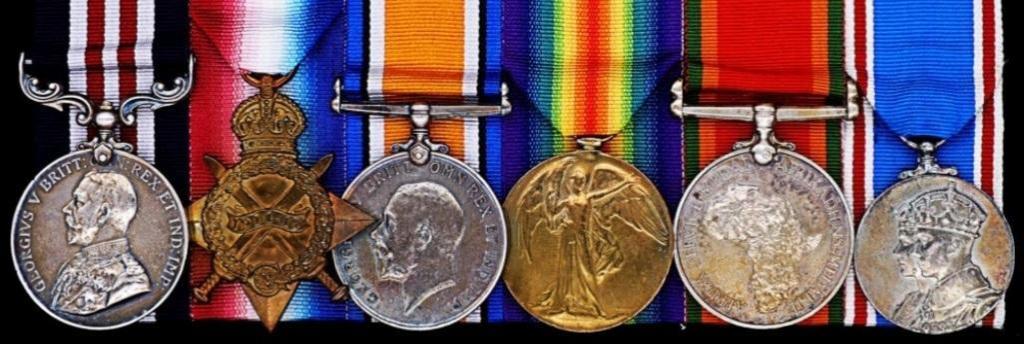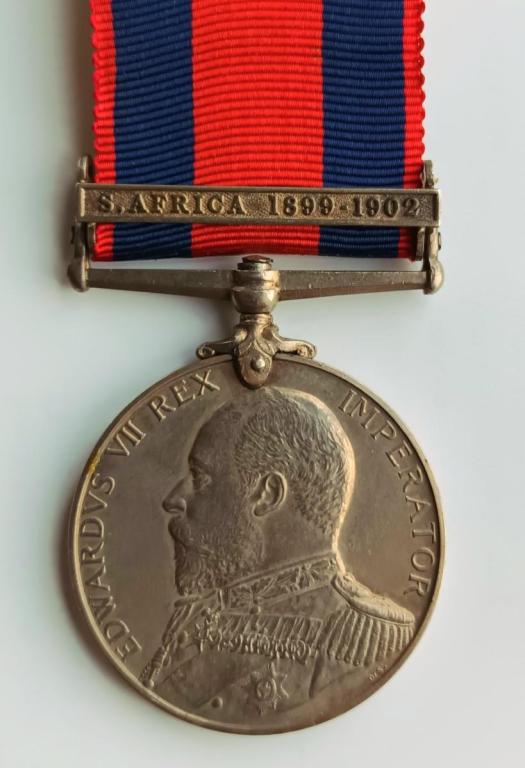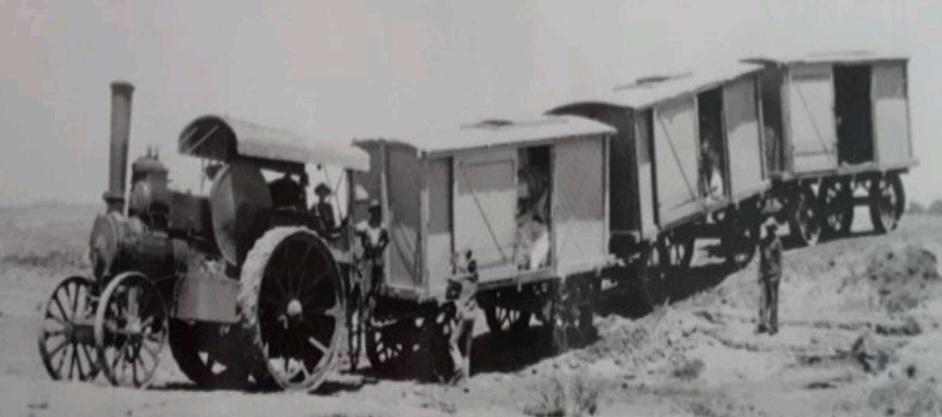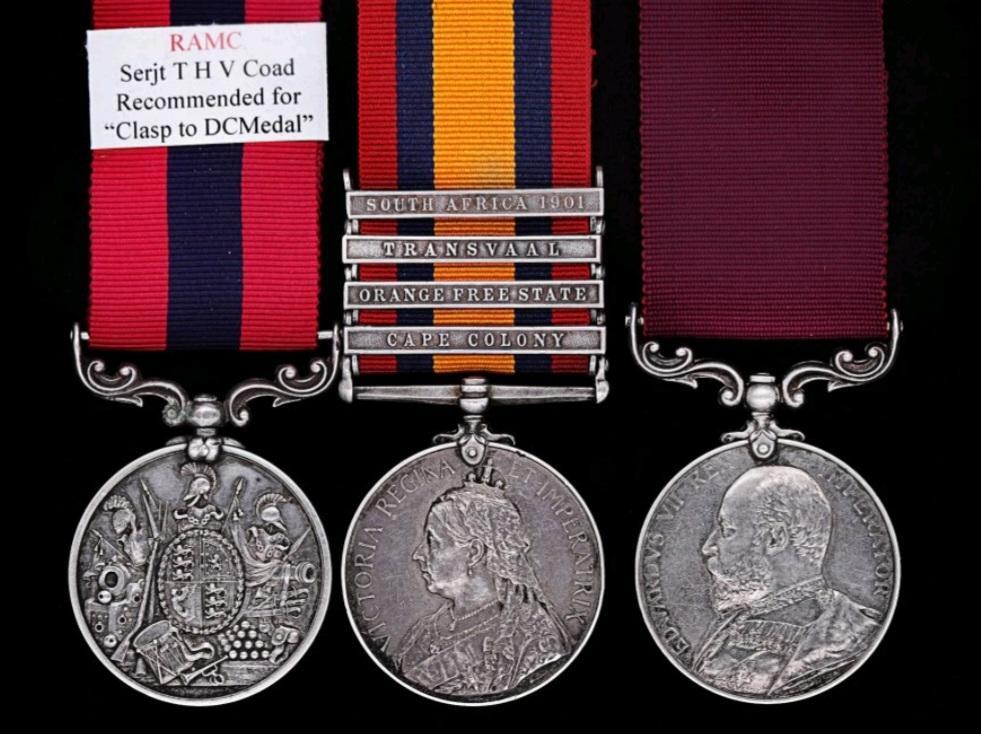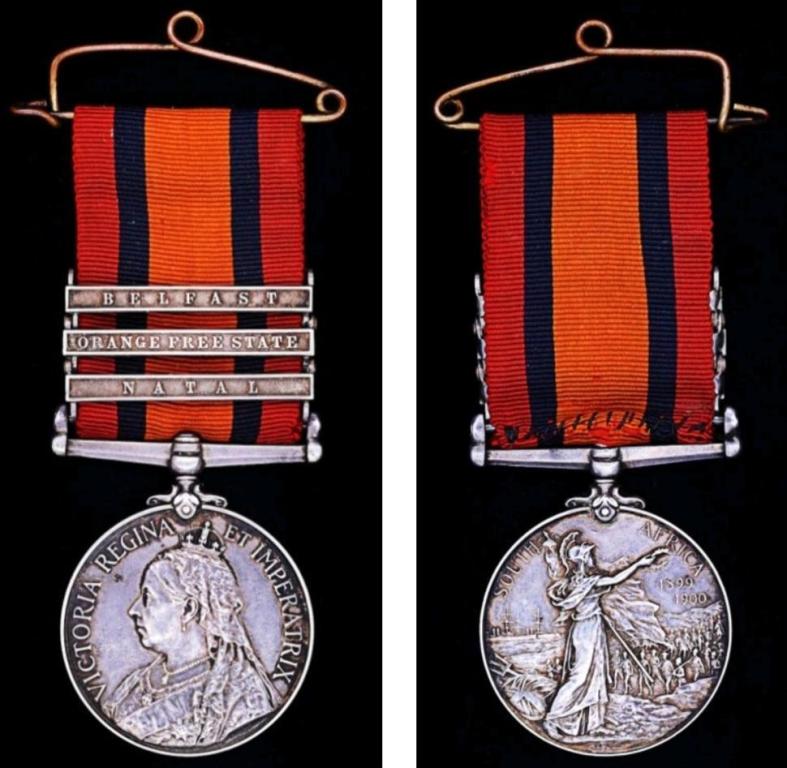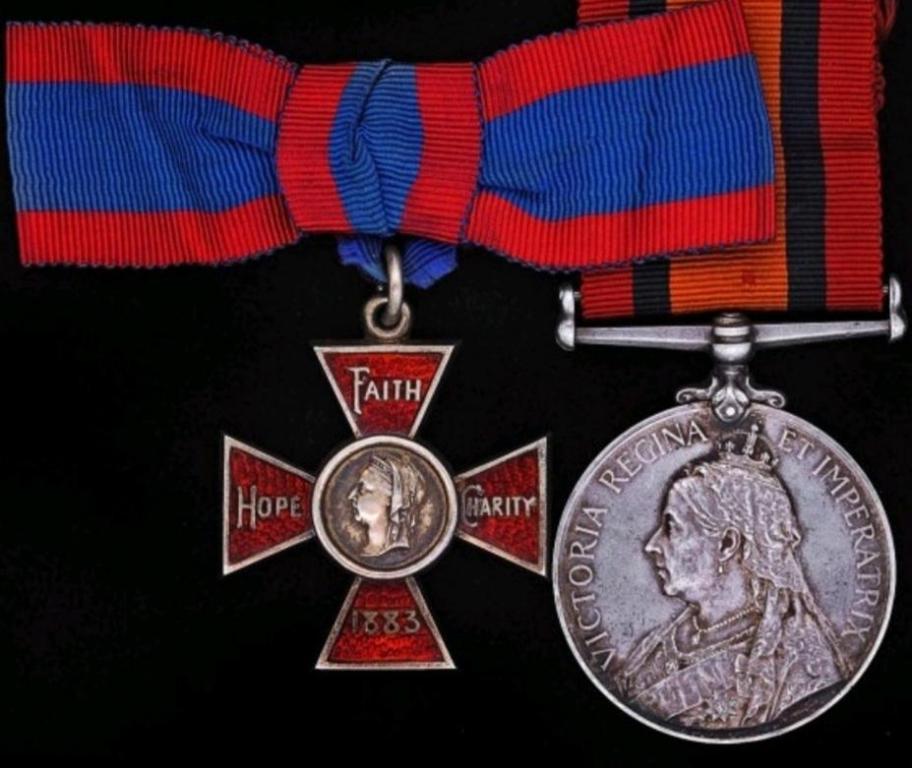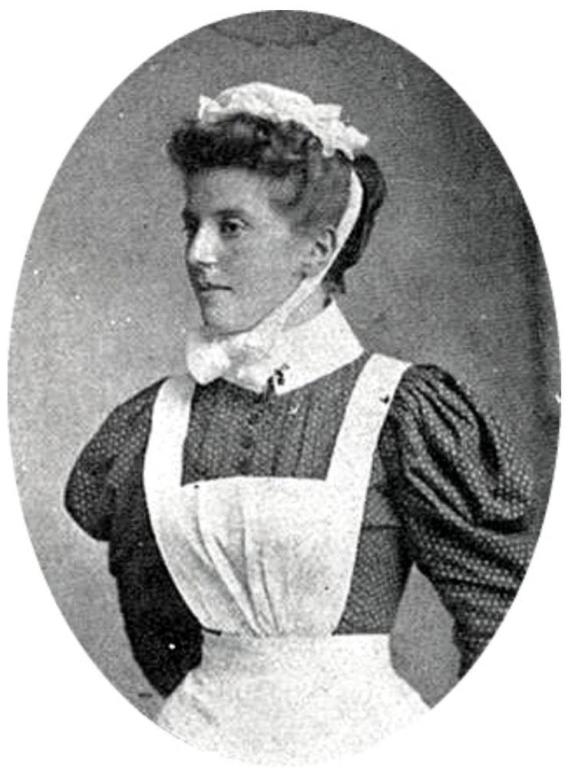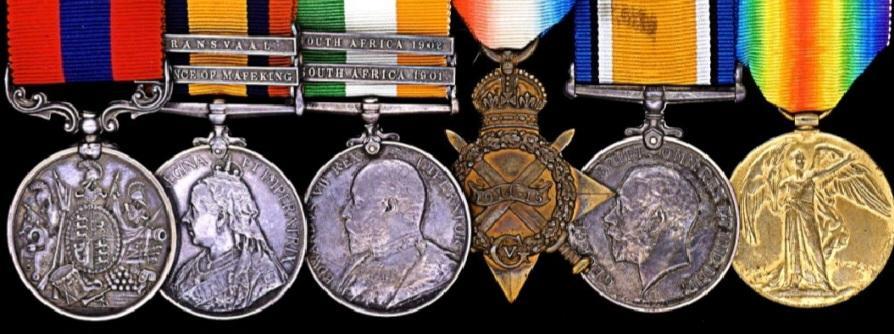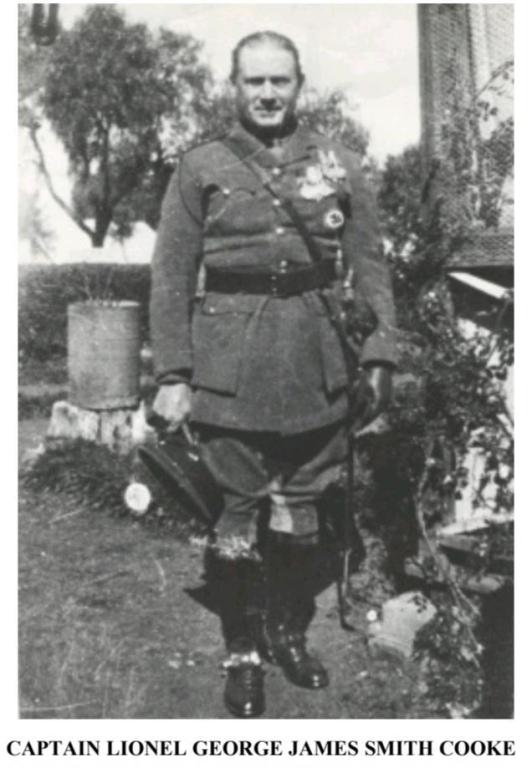-
Posts
1,593 -
Joined
-
Last visited
-
Days Won
14
Content Type
Profiles
Forums
Blogs
Gallery
Events
Store
Everything posted by archie777
-
Military Cross (MC) (Geo.V); 1914-15 Star 2.Lieut. A. Scragg. Essex R.; BWM; AVM (Brit.) with MID emblem Major A.S. Scragg MC LONDON GAZETTE 2 JANUARY 1918 Arthur Scragg was commissioned into 5th Bn Essex Regt. As Second Lieutenant on 16 July 1915 (late Cadet, Woodbridge School Contingent, Junior Division, Officers Training Corps.). Joined his unit at Mudros in December 1915 with a draft of 45 men. Along with 80 men he served with the Armoured Train Garrison before returning to his Battalion in May 1916. He was later attached to the Egyptian Camel Transport Corps (ASC). He was awarded his Military Cross whilst serving as a T/Lieutenant (Acting Captain) with the Army Service Corps. A citation for the award of this Military Cross has not, as yet been located. He was also Mentioned in Despatches. Arthur was recalled to service during WWII. Holding the rank of Major before the War he was appointed Acting Lieutenant Colonel. Towards the end of 1940 he was recommended for the award of the O.B.E. by the Commander of 1 Corps however this was not confirmed and he was only given a Mention in Despatches (London Gazette 20 December 1940. The original recommendation was worded as follows: “During the advance and subsequent withdrawal, Lieut. Colonel Scragg maintained an ample supply of petrol under difficulties. He was never at a loss for a solution, and acted on his own initiative with fine judgement. His determination and tireless energy in any difficult situation was a fine example to his officers and men. Lieut. Colonel Scragg showed energy, reliability, courage, and skill throughout, and was of the greatest possible assistance to the administrative staff.”
-
1
-
Military Cross (MC) (Geo.V); BWM; AVM (Brit.) 2/Lieut. A.C.S. Estcourt R.A.F. MC LONDON GAZETTE 26 SEPTEMBER 1916 “Temp. 2nd Lt (Temp Lt) Arthur Charles Sotheron Estcourt. Glou. R. For Conspicuous Gallantry in action. He fought his battery with great effect under very heavy fire during the attack, dispersing many enemy bombing parties. He also knocked out a machine gun which was holding up the advance of one of our bombing parties.” Lieutenant Arthur Charles Sotheron Estcourt age: 24, 5th Sqdn. Royal Air Force; formerly 8th Bn. Gloucestershire Regiment; awarded MC; son of the Rev. E. W. Sotheron-Estcourt, of “Windmill” Milford-on-Sea, Lymington, Hants. Scholar of Magdalene College, Cambridge. Gazetted September 1916. Arthur Charles Sotheron Estcourt (26.9.1893) Howson’s 1907 – 1912. Arthur Estcourt died aged 24 on 8 August 1918. He was born at Tetbury, Gloucestershire, the son of Rev. Edmund Estcourt and his wife Eleanor, née Bucknall. The 1891 Census records the family of nine living at the Shipton Moyne Rectory, Long Newnton, Wiltshire with six servants. Arthur’s mother died when he was four years old, and the following Census, in 1901, sees him living with his father, his older sister Margaret and his younger brother Walter who also later attended Gresham’s (Howson’s 1907-9). Arthur attended St. Aubyn’s School in Rottingdean, Sussex, before being registered at Howson’s with the award of a Fishmongers’ Scholarship worth £50 per year in May of 1907. The young man soon proves his worth, winning prizes for Latin, French and Mathematics. He participated in the debating society, becoming secretary in 1911, and was heard to express some ‘rather pedantic’ views on women’s suffrage during one debate when he declared that, “spending their lives in works of mercy and charity,” the fairer sex should “always lend themselves to the protection of the chivalrous members of the stronger sex for protection.” Arthur also played cricket for the School House and achieved the rank of Corporal in the OTC. In 1912 he was involved in the ceremony for laying the foundation stone of the Chapel, having the honour of passing a levelling tool to the Prime Warden to test the evenness of the stone. He left in the Summer of 1912 as a School Prefect, with a Leaving Exhibition, The Gresham Magazine recording that he had been awarded a Mathematical Scholarship to Magdalene College, Cambridge. Following his older brother Walter to Magdalene, Arthur did not fulfil his early promise at Gresham’s, a note on his academic record reading: “Rather lazy. Not a 1st class man – ought not to have had an Exhibition. Slow producer.” He was consequently withdrawn by his father in July of 1914 but returned in October having joined the Cambridge OTC. Like his brother, Arthur was a great supporter of the School after leaving and subscribed to both the Chapel and Old Boys’ Funds. In November 1914 Arthur was commissioned in the Wiltshire Regiment and went to France with them a year later being attached to a battalion of the Gloucestershire Regiment. Early in 1916 he was assigned to a trench mortar battery which he at times commanded and was awarded the Military Cross for ‘conspicuous gallantry’ in July for putting out of action a machine gun and its team which had been holding up the advance of a bombing party. In August of that year Arthur was wounded by a sniper’s bullet and was sent home to recover until December. After returning to his battery in 1917 he was severely wounded in August by the premature explosion of a bomb and returned to England again until the end of the year. Early in 1918, like many young men at the time, Arthur decided to transfer to the Royal Flying Corps, passing out top of the exam list at the Flying School in April, and going to the front as an observer with 5th Squadron in May. On the morning of 8 August Lieutenant Estcourt was out on patrol over enemy lines. He was found dead later with his pilot Lt. A.D. Robinson, but owing to confusion in the records over his name and rank, a special search was needed to establish his final resting place, in an unmarked grave at Caix, Somme. Arthur’s Squadron Commander wrote that: “He was one of my most efficient observers, and was a most popular officer,” saying, “His loss is felt deeply in the Squadron.” http://www.greshamsatwar.co.uk
-
Military Cross (MC) (Geo.V); BWM; AVM (Brit.) Lieut. G.B. Cameron MC EDINBURGH GAZETTE 26 SEPTEMBER 1918 “Lt. George Brown Cameron, A.S.C. For conspicuous gallantry and devotion to duty during a raid. He led his company with greatdash and determination, and personally attacked and killed a machine-gun crew and captured a gun. He also led a party forward of his objective to an enemy strong point and completely mopped up dug-outs and trench-mortar emplacements between the second and third objective, his skill and gallantry set a splendid example to all ranks.” The University of Aberdeen roll of service in the Great War records he following: “Cameron, George Brown: Lieutenant, Army Service Corps (attached East Yorkshire Regiment); M.C.; son of Major Cameron, Bogbain, Keith! born Keith, 22 March 1894; matriculated, 1912; graduated B.Sc. (Agr.), 1915, was a very distinguished student, carrying off prizes in all his classes, and was for a time an able president of the Agricultural Society. He was an enthusiast in Agriculture, especially scientific Agriculture, and gave promise of going far both in the study and practice of the subject, but the war came, and his efficiency had to be diverted to another channel. Cameron was commissioned in the 1st Highland Divisional Transport, A.S.C., in April 1915, and went abroad about a year later. In France he was attached to the 7th Battalion East Yorkshire Regiment and proved himself a most excellent officer. He was awarded the M.C. in 1918” - "for very gallant work when in command of a company during a big raid by his Battalion on the enemy trenches at Beaumont-Hamel on the night of 8 June 1918. His leadership was magnificent and greatly assisted in making the enterprise a success." He died of wounds in the advance on Flers, 26 August 1918.”
-
1
-
BWM L/SJT S. Burroughs S.A.S.; AVM (Bil.) CPL S. Burroughs S.A.S. Sydney Burroughs (Musketry Instructor, South African Police) enlisted on 10 April 1916. He was then 41 years old and was given the Regimental number ‘9’ being one of the first 17 marksmen who joined this specialised unit. He had previously served with the 15th and 19th Hussars. He served right until the end of the War, discharged at Maitland on 11 July 1919. In response to a British War Office request, a small sharpshooter’s unit was formed in South Africa to serve in Europe. Recruited and financed by Sir Bailey, the unit was named Bailey’s South African Sharpshooters and fought in France and Belgium from April 1916 to the Armistice, in a British Division. A total of 24 men served in this formation, of whom 6 were killed in action and 7 received medical discharges after injuries. The Bailey’s South African Sharpshooters reckoned to have killed more than 3 000 Germans.They left South Africa in three batches. The first of 17 men leaving 22 April 1916 in R.M.S. Saxon and arriving in France 30.5.16 in time for the Battle of the Somme. The unit was attached to the KRRC and the Northamptonshire’s of the 2nd Brigade 1st Division under Major General Strickland and served until the Occupation of Germany. Lieut. Methven, the officer in charge received a glowing testimonial from General Strickland. A number were decorated, 6 were killed in action, 7 receiving medical discharges.
-
Military Medal (MM) (Geo.V) 373 Pte A.B. Sjoberg 2/S.A.Inf:; BWM; AVM (Bil.) Pte A.B. Sjoberg 2nd S.A.I.; ASM ACF153727 A.B. Sjoberg; Médaille de la Somme de 1914-1918 et de 1940 (Medal for the Somme) unnamed as issued MM LONDON GAZETTE 25 JUNE 1918 “On 27th March 1918 at Dernancourt during a critical time in the retirement of part of our troops, this man acted with conspicuous gallantry in the face of heavy shell and machine gun fire, and showed great resource and initiative in handling his Lewis gun. By his fine example of coolness and determination the small force, covering the retirement, were able to hold on to their position until finally relieved some hours later.” Albert Bernard Sjoberg was born in Sydney, Australia in about 1897. In attesting for service with the South Africa Overseas Expeditionary Force on 17 August 1915 he indicated that hisnext-of-kin was his mother, Mrs. Mary Alice Sjoberg, of Vincent Road, Clifton, East London. Posted to “D” company of the 2nd Infantry Battalion he served in Egypt from 13 January 1916 to 15 April 1916 and crossing immediately to France he served there from 16 April 1916. He was wounded in action, receiving a gunshot wounded in his back, on 12 October 1916. In 1917 he was posted to “B” Company and returned to France on 17 February 1917. After re-joining his unit on 26 March he was once again wounded on the right shoulder l on 21 September 1917 and returning to his Unit on 24 October 1917. It seems as if he was once again wounded, soon after earning his Military Medal, on or about 30 April 1918. He was finally discharged from service on 24 May 1919. During WWII he served with 55th Coy M.E.B., (S.A.E.C.) and 21 (M.E.B.) N.E. Rand Armd. Comds. serving from 2 May 1941 until his discharge on 31 December 1946
-
1
-
Military Medal (MM) (Geo.V) 3811 Pte L.H. Suttie 2/S.A.Inf.; BWM Cpl L.H. Suttie 2nd S.A.I.; AVM (Bil.) Cpl L.H. Suttie 2nd S.A.I.; 1939-45 Star; Africa Star; DM; WM; ASM 144731 L.H. Suttie. MM LONDON GAZETTE 14 JANUARY 1918 The MM citation is worded as follows: 3811 Private Lawrence Hendley Suttie, 2nd Regiment South African Infantry "For conspicuous bravery during the operations EAST of YPRES on the 20th and 21st September 1917. He showed magnificent courage and devotion to duty throughout the action and as a company runner safely delivered several important messages to Battn. Headquarters without loss of time, although on occasions a heavy enemy Artillery barrage had to be passed through. On returning to the front line he was on all occasions loaded with water, ammunition and stores according to the requirements of his company. This man was also employed in running along the front line under rifle and machine gun fire. His conduct throughout was splendid. He was wounded in the execution of his duty on the evening of the 21st". Lawrence Hendley Suttie was born in Pietermaritzburg in 1896. He was educated at The Boy's Model School in the city. On his discharge from the Army in 1919 he returned to Pietermaritzburg and took up a position with the local municipality. On the outbreak of the Second World War he joined the Natal Carbineers, and refusing a commission, fought in the ranks during the Abyssinian campaign. He re-joined the municipal Water Department on his return and after rising to the senior position of City Engineer he retired in 1958. Hereafter he joined the Natal Tanning Extract Company until his final retirement in 1965 just three years before his death in 1968. Lawrence Suttie served with the 2nd S.A.I. in France and Flanders. He was wounded on three occasions, on 11 October 1916, on 12 April 1917 (Arras) and on 21 September 1917 (Ypres). He was awarded his MM on 27 October 1917 and was presented with his medal ribbon on the parade held after the Memorial Service at Delville Wood on Sunday 17 February 1918. On this occasion he following citation was read out at the presentation: "For conspicuous gallantry near YPRES on 20th/21st September, 1917. As a Company runner he delivered important messages under heavy shell fire and carried water and ammunition to the front line. He was eventually wounded in the execution of his duty". He was commissioned after the end of hostilities on 21st December 1918. In a note dated 4 April 1986 Suttie's widow wrote as follows: "He joined up in 1915 and went through Delville Wood without a scratch but later in the battle of Passchendale Ridge he was a dispatch runner and a sniper shot him right through the back. He said he lay quiet for a while till all seemed safe, he got up bleeding badly and all he remembered was falling into headquarters then waking up in hospital. The D (doctor) told him he was the luckiest man alive (as) the bullet had just missed his spine. He had the two bullet marks all his life. But that wound never worried him. In another battle he was wounded in the arm pit and through that he had to give up his cricket, because when he lifted his arm high it gave way and he would clasp his other arm and nothing could be done till it released itself otherwise he enjoyed life till he was 72. He won the Military Medal for bravery at Passchendale Ridge and became a lieutenant. At the end of the War he was made Repatriation Officer to the SA troops with the result he only arrived back in South Africa in September 1919." The History of the South African Forces in France by John Buchan (p 142-144) offers some insight into the nature of the fighting on 20th September 1917 at Ypres: "Few struggles in the campaign were more desperate or carried out in a more gruesome battlefield. The mass of quagmires, splintered woods, ruined husks of "pill boxes", water filled shell holes, and foul creeks which made up the land on both sides of the Menin Road was a sight which, to the recollection of most men, must seem like a fevered nightmare. It was the classic soil on which, during the First Battle of Ypres, the 1st and 2nd Division had stayed the German rush for the Channel. Then it had been a battered but recognizable and featured countryside; now the elements seem to have blended with each other to make of it a limbo outside mortal experience and almost beyond human imagining. Only on some of the tortured hills of Verdun could a parallel be found. The battle of 20th September showed to what heights of endurance the British soldier can attain. It was an example, too, of how thought and patience may achieve success in spite of every disadvantage of weather, terrain, and enemy strength. Delville Wood was still for the Brigade the most heroic episode in the War. But its advance on 20th September must without doubt be reckoned its most successful achievement up to that date in the campaign. It carried one of the strongest of the enemy's position, and assisted the brigades both on its right and left to take two forts which blocked their way The 2nd Regiment had 61 killed (including 3 officers), and 244 wounded and missing."
-
2
-
Military Medal (MM) (Geo.V) 423 Pte H.J. Sherman 1/S.A. Inf :Bn; BWM; AVM (Bil.) 9L/CPL H.J. Sherman. 1ST S.A.I.; S.A.W.S. Medal unnamed as issued. MM LONDON GAZETTE 19 JANUARY 1917 Henry James Sherman was born at Port Elizabeth in 1896. He was educated at Marist Brothers College and then worked as a salesman for Mosenthal & Co., wholesaler merchants. Attested at Potchefstroom 16 August 1915 for service in “B” Company of the 1st South African Infantry Battalion of the South African Overseas Expeditionary Force. Served in Eqypt 12 January 1916 – 12 April 1916. He was present on 26 February 1916 at the Battle of Agagiya 14 miles south east of Sidi Barrani. South African losses numbered 1 officer and 13 other ranks killed, and 5 officers and 98 other ranks wounded. The 1st and 3rd South African Infantry battalions were both granted the Battle Honours of "Agagiya" and of "Egypt 1916". Suffered a gunshot wound in the left shoulder 17 July 1916 on the 4th day of the Battle of Delville Wood. His regiment lost 26 men killed and missing on that day. The 1st South African Infantry Battalion casualties over the seven days of the battle numbered 583, comprising 192 killed, died of wounds or missing, 363 wounded and 26 prisoners of war. Sherman spent the next two months in hospitals in France and England. Served in France again 20 September 1916 – 3 November 1916. During this period the South Africans suffered casualties of approximately 1 150, including 45 officers of whom 16 were killed. At this time the major action of the 1st S.A.I. was its attack on the Butte de Warlencourt on 18 October 1916. Quote from Shermans' letter home dated 11 November 1916. “The night I got my present was the 18 October 1916, while I was guiding a party of Scottish in for working purposes. We got half way down the communication trench and the Gerries started strafing it, causing a wild dash for cover. Before I knew where I was, someone from behind sent me flat on my face, and just as I was about to get up, the trench was blown up by a high explosive, sending me flat again. They pulled me out but I was finished. I got into an old German dug-out more dead than alive, but not too bad to struggle back after showing them their work. I carried on the best I could the next day, after telling what had happened; a sprained leg (left, slight) and both hips, which have now become natural. The worst was the blow on the kidneys, which I am still suffering from." Earlier in the same letter Sherman describes his experiences as a chief runner. He closes with the words: “I then made my way back to headquarters again with my report which was lengthy, and I must say the Colonel was pleased to a certain extent." His M.M. award must have been for good work as a runner. Awarded the MM in the LG 19 January 1917. No official recommendation could be traced, but this Regimental Testimonial of Gallantry dated 15 January 1918 tells the story of his gallantry in the attack on the Butte de Warlencourt. He was in hospital in France, Ireland and at Richmond Park from 20 October 1916 suffering from rheumatism and diarrhea. For the following eight months he served in England at the Cavalry Command Depot, Eastbourne and with the 1st Reserve Battalion. Returned to France 13 July 1917 and joined ”B” Company 1st S.A. Infantry. Back to England on 21 September 1917 and attached to the Discharge Depot. He reverted to the ranks voluntarily on 10 October 1917. Promoted Lance Corporal 30 October 1918, Corporal 28 January 1919, Lance Sergeant 24 June 1919 and Sergeant 29 September 1919. Posted to South Africa 21 November 1919 and discharged at Cape Town on 14 January 1920. He was mentioned in a War Office Communiqué dated 28 August 1919. Sherman was the first choice in the selection of a group of six ex-servicemen from Port Elizabeth and Walmer to attend the official Unveiling Ceremony of the South Africa National War Memorial at Delville Wood held on 10 October 1926. During World War II Sherman served as a Special Constable in the Walmer Civilian Protection Services 25.8.1941 – 31.8.1945. He was an extremely enthusiastic supporter of the annual reunion parades and dinners of members of the 1st South African Infantry Brigade. Sherman died at Port Elizabeth in 1971.
-
2
-
Military Cross (MC) (Geo.V) and bar A/Maj. Edward Gordelier Ridley 74th Siege Bty.; 1914-15 Star Sjt. E.G. Ridley V.K.2.; WM; AVM (Bil.) MID oak leaf Major E.G. Ridley MC LONDON GAZETTE 1 FEBRUARY 1919 “South African Force. T./Capt. (A./Maj.) Edward Cordelier Ridley, 74th Siege Bty., South African Hvy. Arty. For conspicuous gallantry and devotion to duty in keeping his battery inaction during the operations east of Arras between 26th August and 2nd September, 1918. On three occasions when the battery was moving into new positions it came under very heavy shell fire, suffering numerous casualties. He was tireless in his efforts to select good positions for guns and observation posts.” BAR MC LONDON GAZETTE 1 JANUARY 1919 “*T /Capt. (A./Maj.) Edward Gordelier Ridley, M.C., 74th S. By., R.G,A. (S.A.H A.).” ADDED NOTE - In the cases marked by an asterisk * the announcements of awards of the Military Cross have not yet been published in the London Gazette, these awards will be published in due course. The London Gazette, 11 January, 1916. Oversea Contingents: South Africa, Artillery. The undermentioned Temporary Second Lieutenant to be temporary Lieutenant: - Dated 1st January, 1916. Edward Gordelier Ridley. Edward Gordelier Ridley was born 13 April 1884. He first enlisted with the Royal Marine Artillery on 18 January 1902.
-
1
-
Military Medal (MM) (Geo.V) 13533 PTE A.J. Manzie.2/S.A. Inf.; 1914-15 Star PTE A.J. Manzie. 1st Infantry; WM; AVM (Bil.) PTE A.J. Manzie. 2/S.A. Inf; ASM ACF145182 A.J. Manzie; Coronation Medal 1937 (Geo.VI) engraved: A.J. Manzie MM LONDON GAZETTE 20 AUGUST 1919 Private Andrew John Manzie 2nd Battalion, The South African Infantry, was born in Kimberley in 1896. After serving in German S.W.A. with the Durban Light Infantry he then served with the10th S.A.I. in G.E.A. Discharged temporarily medically unfit at Roberts Heights on 26.2.1917 he re-attested with the 2nd S.A.I. on 9.3.1917 and served in France from 27.7.1917. He was seriously wounded during the fighting at Marrières Wood on 24.3.1918. He was sent to Richmond Hospital in England as his injury was severe, his leg being amputated at the knee. He did not recover well from the surgery and this meant that he remained in the UK. Andrew was cared for at the South African Military Hospital in Richmond, which was where he participated in the embroidery of the St Paul’s Cathedral World War I Altar Frontal. In 1919 stump healed, fitted with artificial limb and embarked for South Africa. Discharged medically unfit 3.1.1920. Manzie served as S/Sgt with 19th Batt. N.V.B. 26.7.19; transferred to 3rd Bn. Railway and Harbour Bde. 4.1.1943. Discharged 31.12.1946. Occupation: Clerk Station Master, Durban.
-
Hi Rusty, Excellent thread and medal. I'm fortunate to have one in my collection , must still do research on the recipient Regards Archie
- 1 reply
-
1
-
Hi Tracy, Thanks for your compliment, but I'm still new here and have so much more to learn Regards Archie
-
Hi Megan, Thanks, I did visit the site and started chatting to Ilya Regards Archie
-
Hi Marco, Thanks a million. Yes the ribbon is correct, but I didn't have a picture before Regards Archie
-
On the 21st March 1918, the Germans launched a major offensive with the aim to win the War. After a terrible shelling, units of the South African Infantry Brigade sustained the first clash at Gauche Wood (between Péronne and Cambrai) they were far outnumbered and collapsed after a heroic resistance. After three days of fights and withdrawals, the remains of the Brigade entrenched in Marrières Wood (between Péronne and Bapaume) with orders to stand at all cost. They were practically annihilated. General Tudor had instructed Brig-General Dawson and the remainder of the Brigade to form a blocking position and hold it at all costs. This they did but at an appalling cost in men of the Brigade. By Saturday, the remnants of the South Africans had taken up their positions at Marrières Wood. Exhausted, with few rations and little ammunition, isolated from other friendly forces and under heavy artillery fire, they had little knowledge of the situation except that it was desperate. On the Sunday, the South Africans were well placed for defence with a clear field of fire but this meant that there was no possibility of retreat. The Germans massed for an attack and the South Africans were even bombarded by British artillery. The fighting raged all day and ammunition was becoming very scarce with no fresh supplies coming forward. Casualties were heavy and, despite many gallant deeds by all ranks, the position had become untenable. Surrender had become inevitable. Outnumbered and out of ammunition, but by no means outfought, Brig-Gen Dawson realised that any further resistance would be futile. It would lead to unnecessary loss of lives on the part of the South Africans and it would not serve any tactical purpose. What they had set out to do was manifested in the delay of the German advance, with kilometres-long traffic jams that they witnessed while being marched as prisoners of war through the rear area behind the German frontline. Out of an initial 500 men, all ranks, at the end of the battle about 100 men were left, including the wounded. It was a deed of self-sacrifice, valour and unparalleled heroism.
-
Military Medal (MM) (Geo.V) 893 Pte G.F. Baker 1/S/Afr.I.R.; 1914-15 Star; BWM; AVM (Bil.) MM LONDON GAZETTE 2 NOVEMBER 1917 The Citation reads as follows: “At Longueval on 16 July during the attack on enemy trench Lt. Craig fell severely wounded out in the open between two trenches. The attack proved successful and the men were brought back. Privates Estment and Baker scaled the parapet and assisted Private Faulds in bringing back Lt. Craig. The return was made under heavy machine gun fire. Private Baker getting two bad wounds. The prompt act saved the officer’s life.” John Buchan, in his history of The South African Forces in France, puts these events in perspective when he wrote as follows: “All through the furious night of the 15th the troops in Delville Wood were working for dear life at entrenchments. At 2.35 a.m. Lukin received orders from the division that at all costs the northern entrance into Longueval must be blocked, and that for this purpose his Brigade must complete the capture of the northern perimeter of the wood, and advance westwards till they joined hands with the 27th Brigade. …. while two companies of the 1st South Africans (those which, as has been already explained, had formed a defensive flank at the south-west corner of the wood) were to push north from the Princes Street line. The situation did not allow of a previous military bombardment; but it was arranged that a “preparation” by trench mortars should precede the infantry attack. The advance was made at ten on the Sunday morning and failed completely, since the Royal Scots were held up in 20 their area by a strongly-wired stone redoubt and the South Africans by machine-gun fire from the ominous orchard between two roads. It was then that Private W.F. Faulds of the 1st Regiment won the first Victoria Cross which fell to the lot of the Brigade. Lieutenant Craig had attempted to reach a German trench with a bombing section, and had fallen severely wounded half-way between the lines. He was rescued by Private Faulds, who, along with Privates Baker and Estment, crossed the parapet in broad daylight under a drenching machine-gun and rifle fire.” George Baker recovered from his wounds but was later killed in action at Fampoux on 13 April 1917.
-
Military Medal (MM) (Geo.V) 4787 PTE A. Estment 1/S. Afr. I.R.; BWM SJT A. Estment 1ST S.A.I.; AVM (Bil.) MM LONDON GAZETTE 21 SEPTEMBER 1916 “At Longueval on 16 July during the attack on enemy trench Lt Craig fell severely wounded out in the open between two trenches. The attack proved successful and the men were brought back. Privates Estment and Baker scaled the parapet and assisted Private Faulds in bringing back Lt. Craig. The return was made under heavy machine gun fire. Private Baker getting two bad wounds. The prompt act saved the officer’s life.” This was the same Delville Wood action for which William Frederick Faulds was awarded the Victoria Cross. John Buchan, in his history of the South African Forces in France, puts these events in perspective when he writes as follows: “All through the furious night of the 15th the troops in Delville Wood were working for dear life at entrenchments. At 2.35 a.m. Lukin received orders from the division that at all costs the northern entrance into Longueval must be blocked, and that for this purpose his Brigade must complete the capture of the northern perimeter of the wood, and advance westwards till they joined hands with the 27th Brigade. There was a lane called North Street, which was a continuation of the main street of Longeville from the point where the Flers Road branched off to the north-east. Between these roads lay an orchard – the tactical importance of which will be important from the map. The plan was for the 27th Brigade to push north through the village and capture that orchard and the enclosures east of North Street, and to join hands with the South Africans on the Flers Road. This was to be the work of the 11th Royal Scots, while two companies of the 1st South Africans (those which, as has been already explained, had formed a defensive flank at the south-west corner of the wood) were to push north from the Princes Street line. The situation did not allow of a previous military bombardment; but it was arranged that a “preparation” by trench mortars should precede the infantry attack. The advance was made at ten on the Sunday morning and failed completely, since the Royal Scots were held up in their area by a strongly-wired stone redoubt and the South Africans by machine-gun fire from the ominous orchard between two roads. It was then that Private W.F. Faulds of the 1st Regiment won the first Victoria Cross which fell to the lot of the Brigade. Lieutenant Craig had attempted to reach a German trench with a bombing section, and had fallen severely wounded half-way between the lines. He was rescued by Private Faulds, who, along with Privates Baker and Estment, crossed the parapet in broad daylight under a drenching machine-gun and rifle fire.” Alexander Estment was born in the Cape Colony in about 1885. His attestation papers, dated 4 September 1915 indicate that he served for 3 years with Nesbit’s Horse during the Boer War. However, there is no reference to service in German S.W.A. He served with his unit in North Africa in early 1916 and served in France from April 1916 until April 1917 and again from April 1918 until he was severely wounded in the face and eye on 18 April 1918. He was promoted L/Cpl on 6 September 1916, Corporal 10 October 1916 and Sgt. on 18 October 1916.
-
The heroic stand by South African troops at Delville Wood during those dark days in July 1916 are, even today, revered as South Africa’s most heroic contribution to the Great War. It was on that square of “South African soil” where South Africans have honoured their war dead for more than a century. It was there that the first “Delville Wood Memorial” was built and opened with a solemn reverent ceremony in 1926. Notwithstanding changing political regimes here, this is where the Memorial was rebuilt to highlight the part that South Africans have played in subduing the conflicts of the World - and that their country has a worthy place in the family of Nations. Sadly, other equally heroic fights, not least the epic Battle at Marrières Wood in March 1918, would also severely test the mettle and resolve of the South Africans. The words written by John Buchan in the aftermath of the Great War are worth repeating: “The six days and five nights during which the South African Brigade held the most difficult post on the British front - a corner of death on which the enemy fire was concentrated at all hours from three sides, and into which fresh German troops, vastly superior in number to the defence, made periodic incursions only to be driven back - constitute an epoch of terror and glory scarcely equalled in the campaign. There were positions as difficult, but they were not held so long; there were cases of as protracted a defence; but the assault was not so violent and continuous. The high value the enemy set upon it [Delville Wood] is proved by the fact that he used his best troops against it ..... The South Africans measured their strength against the flower of the German army, and did not draw back from the challenge. As a feat of human daring and fortitude the fight is worthy of eternal remembrance by South Africa and Britain, but no historian’s pen can give that memory the sharp outline and the glowing colour which it deserves. Only the sight of the place in the midst of the battle – that corner of splinters and churned earth and tortured humanity – could reveal the full epic of Delville Wood.” The South African Forces engaged were honoured by the award of the Victoria Cross to Private Faulds’s of the 1st South African Infantry, the citation for this prestigious award as follows: “For most conspicuous bravery and devotion to duty. A bombing party under Lieut. Craig attempted to rush over 40 yards of ground which lay between the British and enemy trenches. Coming under very heavy rifle- and machine-gun fire the officer and the majority of the party were killed or wounded. Unable to move, Lieut. Craig lay midway between the two lines of trench, the ground being quite open. In full daylight Private Faulds, accompanied by two other men, climbed over the parapet, ran out, picked up the officer, and carried him back, one man being severely wounded in so doing. Two days later Private Faulds again showed most conspicuous bravery in going out alone to bring in a wounded man, and carried him nearly half a mile to a dressing station subsequently re-joining his platoon. The artillery fire was at that time so intense that stretcher bearers and other considered that any attempt to bring in the wounded man meant certain death. This risk Private Faulds faced unflinchingly, and his bravery was crowned with success.” As recorded in this citation Pte Faulds was accompanied by two other men in rescuing Lieutenant Craig. Both these “two other men” were awarded the Military Medal for their part in this “Victoria Cross Action”.
-
Hi Megan, Don't know why I said that, because it is the correct ribbon. Do you maybe have a link for that picture on wawards.org? Regards Archie
-
In October 1899 the War Office decided to make use of steam transport in a supporting role to animal transport and a new organisation was created with Col. J.L.B. Templer (at the time Superintendent of the Balloon Factory at Aldershot) as Director of Steam Road Transport. On 1 November 1899 a new Royal Engineers company, the 45th Coy, was authorised specifically to operate steam road transport in South Africa. On 15/16 November 1911 engines, supplies and members of Steam Road Transport sailed forSouth Africa, followed on 5 December by Col Templer, his deputy Capt. Gardiner, Mr H.L. Templer (relative??), 11 artificers and 9 more traction engines. The ship, SS Denton Grange ran aground at Las Palmas and the men and cargo only reached South Africa late in January 1912. Henry Lethbridge Templer was born in Armagh, Ireland in 1871 and served a mechanical engineering apprenticeship in London. Who’s Who (South Africa) entries between 1908 and 1913 stated: “Came to C.C. 1900 as Chief Engnr. of H.M. Steam Road Transport and was in charge of traction engines during the Boer War”. This is in line with his MID in the LG of 16 April 1901 “Chief Engineer H L Templar, for work with traction engines”. Roberts commented in the same despatch “…. where coal and water were readily obtainable, the engines proved a valuable adjunct to animal draught….” and a prophetic wish “...if an efficient oil motor could be substituted for the steam motor, as in that case no water would be wanted, while the coal would be replaced by a more portable and concentrated description of fuel.” COLONEL TEMPLER AND HIS STEAM SAPPER In September 1915 Templer joined the Army Service Corps in the UK as a Captain, with promotion to Major in February 1916. After serving as O/C of the MT (Motor Transport) Depot, Camberwell, he was O/C Base MT Depot in East Africa (March 1916-Aug 1917) and was MiD in the LG, 18 February 1917 p 1353. On 16 Nov 1917 he was transferred to the RAF and employed on aircraft production, leading to his appointment as Assistant Controller, National Aircraft Factories with rank Act Lt Col on 8 October 1918. According to his SA Record of Service form he was back in Johannesburg in November 1919 with the rank of Lieutenant-Colonel. During his war-time service Henry Templer was actively involved at top level with two new means of transportation in warfare: Mechanical Traction (1900) and Aircraft (1918). One wonders what would have been his thoughts on the equipment used in the Namibian/Angolan Bush War in the 1980’s!
-
Distinguished Conduct Medal (DCM) (Vict); QSA 4 bars: CC, OFS, Tvl, SA’01; Army LS&GC Medal (Edw. VII): 5738 Serjt. T.H.V. Coad R.A.M.C. Thomas Coad attested as Private in the Army Hospital Corps on 7 January 1884. He served inEgypt from November 1884 to July 1885, Cyprus July 1885 to April 1886 and again in Egypt till May 1889. His Boer War service was from 9 November 1899 to 20 September 1901 and he finally took his discharge at Aldershot on 16 September 1907. On his Discharge Papers he was noted as: “Trained Sick Attendant. Superintending Cook in Military Hospital. Mentioned in Despatches 10.9.1901, 29.7.1902” His MID of 10 September 1901 led to the award of a DCM, which was gazetted on 27 September 1901. Then in WO 108/165 (Final recommendations: Royal Army Medical Corps June 1901-August 1902). Coad was recommended for a “Clasp to D.C. Medal”. This, however, was downgraded to another MID, gazetted on 29 July 1902. There were only six 2nd Award bars to the DCM approved during the war and they were all dated. Only two of the relevant DCM’s were awarded for Boer War service: if Coad’s bar had been approved he would have been part of a very select group of DCM recipients
-
QSA with RAISED DATED REVERSE 1899-1900 3 bars: Natal, OFS, Belf 340 Pte. A.W. O’Brien Ld. Strathcona’s H. Private O’Brien was also entitled to the clasp SA 1901, which was sent separate from the others. Interestingly, O’Brien retained the original shaped wire hanger from which the medal was suspended when presented by the King. According to a Regimental Order dated 8 October 1900 O’Brien was in a group who left that day to join the Transvaal Police. However, he and 16 of the group returned to duty in the Regiment on 19 October, “having declined to join the Transvaal Police”
-
1
-
Royal Red Cross 1st Class Breast Badge (Vict.) (silver-gilt); Q.S.A. no clasp Nursing Sister. K.G. Hill RRC 1ST CLASS LONDON GAZETTE 10 SEPTEMBER 1901 Earl Roberts. K.G. Despatch p 5968 under Civil Staff, Mafeking Miss C. Hill, Matron, Victoria Hospital, p1094 The Edinburgh Gazette, October 1, 1901, Mafeking. To have the Decoration of the Royal Red Cross. Lady Sarah Wilson. Mother Superior Teresa. Miss Hill. Miss Craufurd. Only 84 awards of the Royal Red Cross were made during the Boer War. Kate Hill was an extraordinary woman as were most who pursued a career in nursing in Victorian England. She travelled to South Africa to help the British forces in their hour of need. An Irish girl by birth – she was born in County Cork in 1871. Having finished her schooling she enrolled in Monkstown Hospital in nearby Dublin for her nursing training…... ….by the time October 1899 the war, which had threatened between the two Boer Republics of the Orange Free State and the Transvaal finally erupted into open conflict… It was especially on the nursing front that the lack of expertise and staff was felt the most keenly. There were simply not enough trained and qualified nurses and doctors to cater for the needs of the military and civilian populations. Whilst undergoing her training at Adelaide Hospital a young Katherine Hill met and worked with one of the most eminent consulting surgeons of his day – Dr (later Sir) Kendal Franks. Franks was a brilliant and artistic man but one who was doomed to marry women whom he outlived. After he had lost his second wife at a young age he remarried for a third time but, again, to a woman who was in indifferent health. Determining to take her to South Africa where the climate would be better suited to her health he made the move in the late 1890’s. It is uncertain as to when Hill followed suit but the records indicate that she came out to South Africa to administer to Franks’ wife. As already indicated the country was crying out for trained, experienced medical personnel and Nurse Hill came as a godsend to the sleepy town of Mafikeng, under siege from the Boers two days after the war had commenced. For details of how she was engaged we must turn to the October 28th 1899 edition of the Nursing Record and Hospital World. The siege endured for a period of 217 days and was lifted only on 17 May 1900. Of military casualties there were not many –certainly not many shot and wounded by Boer bullets or cannon but, as can be imagined, foodstuffs and other vital supplies were soon in short supply. Colonel Robert Baden-Powell described the situation in his report published in the London Gazette of 6 February 1901. It read, in part, as follows: “General Cronje with an army of 3000 Boers and 10 guns, surrounded the place. On the approach of the enemy we sallied out and, in a sharp little engagement, dealt them a severe blow, by which they lost 53 killed and many more wounded, and which had a lasting moral effect. During the first phase of the siege, October and November, General Cronje made various attempts to take the place.These attacks we beat off without difficulty in every case and responded by sorties, varying their nature every time as far as possible, and making them so sudden and so quickly withdrawn as not to give the enemy’s supports time to come up and overpower us. The enemy’s losses in this period were very heavy compared to ours.” Baden-Powell went on to make specific mention of those whose conduct had warranted distinction – these mentions included the Victoria Hospital (Mafeking Hospital) and the Nursing Staff: Miss Hill (Matron) and three nurses, assisted by four volunteers and also by Mother Teresa and six sisters (nuns). So there it was – a 29 year old nurse had been catapulted into bearing the responsibility of a hospital in wartime with the full status of Matron. Baden-Powell went on to say that: “On outbreak of war I took over the town hospital, but at first the administration was not satisfactory, on account of want of supervision, over expense of sores, and sanitation. I therefore appointed an issuer and storekeeper and a sanitary inspector. Both Doctors and Nurses did excellent work. Always shorthanded, and frequently under fire. (All the hospital buildings were struck by shells and bullets) and the first convalescent hospital was wrecked and the second damaged by 94 pound shells.)” In another section of his report he mentioned that: “Miss Hill, the Matron of the Victoria Hospital, was assisted by a number of lady volunteers, in addition to her regular staff. The above ladies worked with the greatest zeal and selfdevotion throughout the siege. The protracted strains of heavy work, frequently carried out under fire, told on most of them, Miss Hill being at one time prostrated by overwork. It was largely due to their unremitting devotion and skill that the wounded, in so many cases, made marvellous recoveries, and the health of the garrison remained so good.” With Mafeking relieved a lady like Matron Hill was not going to stand idle – she moved on to Vryburg a short distance away and assisted at the hospital there for a period before moving down to Wynberg in Cape Town where she continued her sterling work. She was awarded, in addition to the RRC, the Queens Medal - sadly she was unable to sport the Defence of Mafeking clasp on her medal as nursing staff were deprived of this honour no matter how richly deserved. Inevitably affairs of the heart took control and, on 27 June 1902, a couple of months after the cessation of hostilities, she wed a dashing 33 year old Lieutenant in the Cape Police – Claud Edward Wimble in Kimberley. She signed herself “C.G. Hill” for the last time. The son, Ernest Alfred Hugh Edward Wimble was born in Kimberley 1902. The second son, Hewitt Edward Mervyn was born to the couple. He died at El Alamein on 23 October 1942 as a Lance Corporal with the Rand Light Infantry. Perhaps Katherine Hill had been spared the news? There is no report on hand to inform us as to when and where she died.
-
1
-
Distinguished Conduct Medal (Vict.) Sgt. L. Cook, Bechuanaland Rifles; QSA 2 bars: DoM, Tvl. Capt. Lt. L. Cooke, Bechuanaland Rif; KSA 2 bars: SA’01, SA’02 Captain L. Cooke Bech’ld Rifles; 1914-15 Star Maj. L.G.J.S. Cooke, Mafeking Commando; BWM Maj. L.G.J.S. Cooke; AVM (Bil.) Maj. L.G.J.S. Cooke DCM LONDON GAZETTE 19 APRIL 1901 Colonel Baden Powell in his official Despatch published in the London Gazette of 8 February 1901 Cooke wrote as follows: “Sergeant Cook (sic), Bechuanaland Rifles specially recommended for clever and plucky scouting, and for gallantry in action (vide separate letter).” Sergeant Cooke’s gallantry was most noticeable during the disastrous action at Game Tree on 26 December 1900. In his published report Baden Powell recorded the events of that day as follows: “The Boers’ work at Game Tree, 2,500 yards north of town, had checked our grazing in that direction, and it commanded our line of communication northwards. Some shells thrown into it a few days previously had caused enemy temporarily to vacate it, showing it to be a weak open work; this had been confirmed by reconnaissance by our scouts, but as the enemy had been seen strengthening it during the past few days, I determined to attack before they should make it impregnable. Accordingly, two squadrons Protectorate Regiment, supported by armoured train and Bechuanaland Rifles, were ordered to attack from the left flank of the work, under direction from Major Godley, while three guns and Maxim prepared the way from the right front of the work. This scheme was carried out at dawn on the 26th, the guns making good practice, and the two squadrons advancing in attack formation exactly as required. But on pressing home the attack a heavy fire killed or wounded most of the Officers and the leading troops. These succeeded in gaining the parapet, but the work was found to have been strongly roofed in and so closed as to be impregnable. The attack fell back upon the eastern face, and pushed forward again on the southern face, but eventually had to retire with the loss of – Captain Vernon, Captain Sandford, Lieutenant Paton, and 21 non-commissioned officers and men killed, and, Captain FitzClarence and 22 men wounded. Three missing. If blame for this reverse falls on anyone it should be on myself, as everyone concerned did their part of the work thoroughly well, and exactly in accordance with the orders I had issued. Both Officers and men worked with splendid courage and spirit.” CAPTAIN LIONEL GEORGE JAMES SMITH COOKE Lionel George James Smith Cooke was born on 2nd May 1872. Service documents record that he first joined the Bechuanaland Rifles as a Private on 1 September 1898. He was promoted Corporal on 13 November 1899 and it was in that capacity that his gallantry during the action at Game Tree earned him his Distinguished Conduct Medal. He is recorded as having taken part in the actions of 26th December 1899 and 12th May 1900 during the Defence of Mafeking. He later took part in various operations in the Transvaal west of Pretoria from July to 29th November 1900 and elsewhere in the Transvaal between 30th November 1900 and 31st May 1902. Stirling in his well known book The Colonials in South Africa 1899-1902 confirms that Captain Cooke was severely wounded at Schweizer Reneke on 2nd January 1902. He was also mentioned in Despatches in the London Gazette of 1 April 1901. Lionel Cooke was promoted Lance Sergeant on 22 January 1900 and as Sergeant on 1 April 1900. He was commissioned after the Relief of Mafeking on 1 October 1900 and a year later as Captain in October 1901. His wartime rank of Captain was reduced to that of Lieutenant in 1903 and having resigned for a short period between 1904 and 1907 he was subsequently reappointed Lieutenant in March 1907 and continued to serve with the Bechuanaland Rifles in that capacity until 30 June 1913 when he was transferred to the Union Reserve of Officers, Mounted Rifles Branch (Section I). At the outset of WWI he was re-employed as a Junior Commandant (Major) with the Mafeking War Commando from 27 October 1914 until 18 February 1915. Once again reverting to the Reserve of Officers he was promoted Captain, Reserve of Officers on 31 August 1921 and as Major and Commandant of the Mafeking Commando, (D.R.A. Organisation) appointment which he finally relinquished on 30 June 1929. In 1974 his widow, formerly Miss L. Hay, recalled a few further details mentioning that she married Major Cooke in 1922 and that he died 23 October 1952 and is buried in the Mafeking cemetery. She mentioned that he was a Master Builder and had built the main part of Mafeking Railway Station. Apparently he was one the five men who put up the money to build the railway line to the border during the Rinderpest scourge. At that time Mafeking was cut off from the North Eastern Transvaal as the railway extended only from Johannesburg to Ottoshoop. He also built the Wesleyan church in Main Street and the dam, commonly called “Cooke’s dam”, which supplied water to Mafeking. He was appointed as Mayor of Mafeking for two years and acted as such for nearly a further two years. He was also at one time Chairman of the Divisional Council. He was interested in many projects and at one time ran the gold mine outside Mafeking called “Madibi” for Anglo American but this was later abandoned as being uneconomical to continue. His wife described him as being keen on horses and that he was a good rider. Scotty Smith had taught him to ride and gave him his first horse. He played rugby and was a champion at golf. She mentioned that she had been employed as Matron of the Mafeking Hospital after the war. She was proud of the fact that the Lord Baden Powell’s stayed with them during their two return visits to South Africa. Of her late husband’s exploits during the Boer War she wrote as follows: “My husband had his decoration for carrying wounded soldier on his back at “Game Tree”. He carried him over the railway line at Mafeking.” Angus Hamilton recorded: “Our guns moved into position during the night, throwing up emplacements for the attack, and as soon as they could see, Major Panzera opened fire. It was yet dark, although there came a faint glimmer of light from the east, but not sufficient to prevent the flashes from the muzzles of the guns and the glow of the bursting shells from being plainly visible. Until that moment there had been no sign of any living thing about the veldt between us and the Boer lines, and there was no sound. We had seen C and D Squadrons creeping to their positions under the guidance of the scout Cooke. Captain Lord Charles Bentinck had deployed across the front of the Boer position, taking up his place upon the left of the line. Close to him and but little in advance, the gunners had ensconced themselves behind a few sods of earth and sacks of sand. These operations marked the preliminary of the fight, from which, as the armoured train steamed to its post, completing the units in our attack, nothing had been omitted which might increase our chances of success.” On another later occasion (30 April 1900) Baillie wrote: “I was rather amused to hear Sergeant Cooke, of the Bechuanaland Rifles, report having slain a Dutchman this morning. He wasn’t in the least elated, and in a shamefaced sort of way said he was afraid it wasn’t a sporting shot. He couldn’t have been more upset if he had shot a hen pheasant siting, but to anyone else the episode was distinctly amusing.” NOTE: Three Victoria Crosses were awarded as a result of acts of heroism during the Siege of Mafeking: Sergeant Horace Martineau and Trooper Horace Ramsden and the third to Captain Charles FitzClarence. All three awards were awarded for Game Tree although Captain FitzClarence’s citation also referred to two previous actions.
-
Hi Gentlemen, First time for me to visit this thread, and all I can say is wow, wow wow. Absoluty excellent information and pictures. I wanted to like the pictures and comments, but unfortunately I'm done with my amount of likes for the day. Thank you so much for everyone's contribution and I will definitely get back yo this thread. I have so much to learn and its really interesting, thanks Regards Archie
-
Hi Megan, Their medals are hard to find and I don't have one myself, except for the drawing. As soon as I get one, I will help you immediately Regards Archie


.thumb.jpg.8f11964f4d04824d881c313e10a95c32.jpg)
